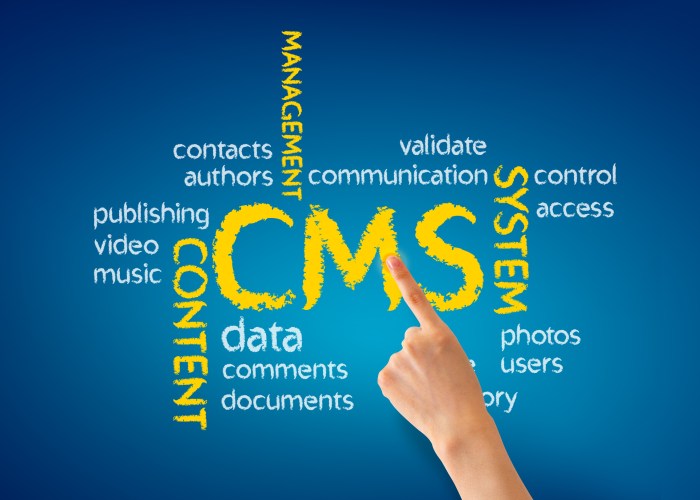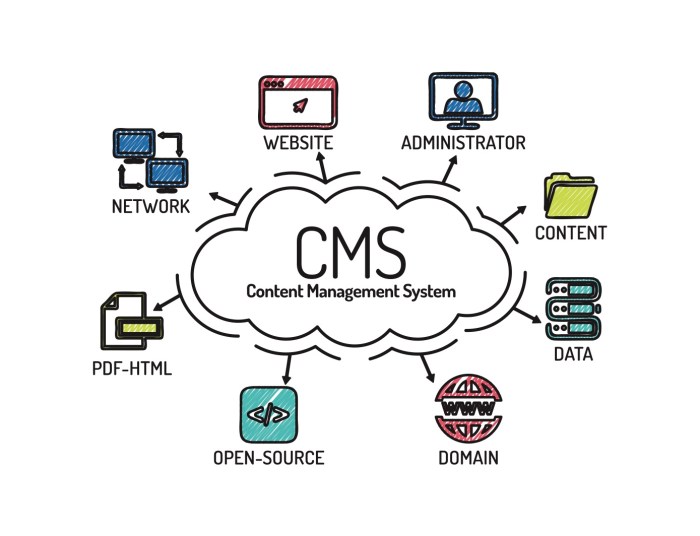What is a CMS?

A Content Management System (CMS) is a software application that allows users to create, manage, and publish digital content, such as website pages, blog posts, images, videos, and documents. It provides a user-friendly interface that simplifies the process of creating and updating web content, eliminating the need for extensive coding knowledge.
Purpose of a CMS
The primary purpose of a CMS is to empower individuals and organizations to control and manage their online presence effectively. It facilitates the following:
- Content Creation and Editing:CMS platforms offer tools for creating and editing various types of content, including text, images, videos, and audio files. Users can easily format, add multimedia elements, and optimize content for different devices.
- Content Organization and Structure:CMS platforms provide features for organizing content into categories, hierarchies, and tags, making it easy to navigate and find specific information. This helps maintain a structured and user-friendly website.
- Content Publishing and Scheduling:CMS platforms allow users to publish content immediately or schedule it for future publication. This enables businesses to plan content releases and maintain a consistent content calendar.
- Website Management:CMS platforms typically include tools for managing website settings, including navigation, menus, themes, and plugins. This empowers users to customize the look and functionality of their website without needing extensive technical skills.
Examples of Popular CMS Platforms
Numerous CMS platforms are available, catering to various needs and website types. Some of the most popular examples include:
- WordPress:A widely used open-source CMS known for its flexibility and extensive plugin ecosystem. It powers a significant portion of websites globally.
- Joomla:Another popular open-source CMS known for its robust features and scalability. It is often used for creating complex websites and web applications.
- Drupal:A highly customizable open-source CMS favored for its advanced features and community support. It is suitable for building large-scale websites and enterprise-level applications.
- Shopify:A cloud-based e-commerce platform that provides a user-friendly CMS for managing online stores. It offers built-in features for selling products, managing inventory, and processing payments.
- Squarespace:A website builder platform that provides a drag-and-drop interface for creating visually appealing websites. It offers a range of templates and features for various website types.
Benefits of Using a CMS
Utilizing a CMS offers numerous advantages for website owners and content creators, including:
- Ease of Use:CMS platforms are designed to be user-friendly, requiring minimal technical expertise. They provide intuitive interfaces and tools for managing content, simplifying the website creation and maintenance process.
- Cost-Effectiveness:CMS platforms can save significant costs compared to traditional website development methods. They eliminate the need for expensive web developers and allow users to manage their websites independently.
- Flexibility and Customization:CMS platforms offer a high degree of flexibility and customization options. Users can choose from various themes and plugins to tailor their websites to specific needs and branding.
- Improved Content Management:CMS platforms provide a structured and organized way to manage website content, making it easier to create, edit, and publish content efficiently.
- Enhanced Capabilities:Many CMS platforms offer built-in features that help optimize websites for search engines, improving visibility and organic traffic.
Types of CMS
CMS platforms can be categorized based on various factors, including licensing, architecture, and functionality. Here are some common types of CMS:
Open-Source CMS
Open-source CMS platforms are freely available and allow users to modify and distribute the software. They offer a high degree of flexibility and customization options, as users can access and modify the underlying code. Examples of open-source CMS platforms include WordPress, Joomla, and Drupal.
Features and Functionalities
- Flexibility and Customization:Users can access and modify the source code, enabling extensive customization and integration with third-party applications.
- Community Support:Open-source platforms benefit from large and active communities that provide support, documentation, and contribute to the platform’s development.
- Cost-Effectiveness:Open-source platforms are free to use, eliminating licensing fees and reducing overall website development costs.
Strengths and Weaknesses
- Strengths:High flexibility, customization, and community support; cost-effective.
- Weaknesses:May require technical expertise for customization and maintenance; security vulnerabilities can arise if updates are not applied promptly.
Proprietary CMS
Proprietary CMS platforms are developed and owned by a specific company, with users typically paying a subscription fee or licensing fee to use the software. These platforms often offer a more streamlined and user-friendly experience, with pre-built features and support from the vendor.
Features and Functionalities
- User-Friendly Interface:Proprietary CMS platforms often prioritize ease of use, with intuitive interfaces and pre-built features that simplify website management.
- Vendor Support:Users receive technical support and updates from the platform vendor, ensuring a reliable and secure experience.
- Security and Reliability:Proprietary platforms typically have dedicated security teams and infrastructure, offering enhanced security and reliability compared to open-source platforms.
Strengths and Weaknesses
- Strengths:User-friendly interfaces, vendor support, enhanced security and reliability.
- Weaknesses:Higher costs compared to open-source platforms; limited customization options; dependence on the vendor for updates and support.
Headless CMS
Headless CMS platforms focus on content management and delivery, decoupling the content backend from the front-end presentation layer. They provide APIs that allow developers to access and integrate content with various front-end technologies, such as mobile apps, single-page applications, and static websites.
Features and Functionalities
- Content-as-a-Service (CaaS):Headless CMS platforms act as a central repository for content, making it accessible to different front-end applications through APIs.
- Flexibility and Scalability:They offer flexibility in choosing front-end technologies and allow for seamless content delivery across multiple channels.
- Developer-Friendly:Headless CMS platforms are designed with developers in mind, providing robust APIs and documentation for integration and customization.
Strengths and Weaknesses
- Strengths:Flexibility, scalability, developer-friendly, content-as-a-service approach.
- Weaknesses:May require more technical expertise for implementation; limited front-end functionality out of the box.
Key Features of a CMS
A typical CMS platform includes various features that facilitate content management, website administration, and user engagement. These features are crucial for managing a website effectively and achieving desired online goals.
Core Features of a CMS
| Feature Name | Description | Example Implementation |
|---|---|---|
| Content Creation and Editing | Tools for creating and editing various types of content, including text, images, videos, and audio files. | WordPress’s visual editor, allowing users to format text, add images, and embed videos. |
| Content Organization and Structure | Features for organizing content into categories, hierarchies, and tags, enabling easy navigation and information retrieval. | WordPress’s category and tag system, allowing users to classify and group content for better organization. |
| Content Publishing and Scheduling | Capabilities for publishing content immediately or scheduling it for future publication, enabling planned content releases. | WordPress’s scheduling feature, allowing users to schedule posts and pages for future publication. |
| Website Management | Tools for managing website settings, including navigation, menus, themes, and plugins. | WordPress’s dashboard, offering options to customize menus, themes, and install plugins. |
| User Management | Features for managing user accounts, roles, and permissions, allowing control over website access and content editing. | WordPress’s user management system, enabling the creation of user accounts with specific roles and permissions. |
| Search Engine Optimization () | Built-in features that help optimize websites for search engines, improving visibility and organic traffic. | WordPress’s Yoast plugin, providing tools for optimizing content, meta descriptions, and sitemaps. |
| Security Features | Measures to protect websites from security threats, such as malware, hacking attempts, and data breaches. | WordPress’s core security updates, regular plugin updates, and security hardening techniques. |
| Analytics and Reporting | Tools for tracking website traffic, user behavior, and content performance, providing insights for improvement. | WordPress’s Google Analytics integration, providing detailed website traffic data and user engagement metrics. |
Choosing the Right CMS
Selecting the appropriate CMS for a specific project is crucial for achieving website goals and maximizing its effectiveness. Several factors should be considered when making this decision.
Factors to Consider When Selecting a CMS

The following factors are essential to evaluate when choosing a CMS:
- Website Type and Purpose:The type of website being built, such as a blog, e-commerce store, or portfolio website, will influence the CMS selection. Some platforms are better suited for specific website types.
- Content Requirements:The types of content to be managed, such as blog posts, product pages, or multimedia content, should be considered. Different CMS platforms offer varying capabilities for handling different content types.
- Technical Expertise:The technical skills of the website developers and administrators should be assessed. Some CMS platforms require more technical expertise for customization and maintenance.
- Budget and Resources:The available budget and resources for website development and maintenance should be factored in. Open-source CMS platforms are often cost-effective, while proprietary platforms may require subscription fees.
- Scalability and Performance:The CMS should be able to handle future growth and traffic increases. Scalability and performance are crucial for ensuring a smooth user experience.
- Security and Reliability:Security and reliability are essential for protecting website data and ensuring a stable online presence. CMS platforms with strong security features and regular updates are preferred.
Checklist for Evaluating CMS Platforms
To evaluate different CMS platforms effectively, use the following checklist:
- Ease of Use:Is the platform intuitive and user-friendly? Can non-technical users easily create and manage content?
- Content Management Features:Does the platform offer the necessary features for managing the desired content types?
- Customization Options:Does the platform allow for customization through themes, plugins, or code? How flexible is the platform?
- Performance and Scalability:How well does the platform handle large amounts of data and traffic? Can it scale to meet future needs?
- Security and Reliability:Does the platform offer robust security features and regular updates? Is the platform reliable and stable?
- Community Support:Does the platform have a large and active community that provides support, documentation, and resources?
- Cost and Licensing:What are the costs associated with using the platform? Are there subscription fees or licensing costs?
Tips for Choosing the Best CMS for Different Website Types and Needs
Here are some tips for selecting the best CMS for specific website types and needs:
- Blogs and Content Websites:WordPress is a popular choice for blogs and content-driven websites due to its ease of use, extensive plugin ecosystem, and capabilities.
- E-commerce Websites:Shopify and Magento are leading platforms for building online stores, offering features for managing products, inventory, and payments.
- Corporate Websites:Drupal and Joomla are suitable for building complex and feature-rich corporate websites, providing robust features and customization options.
- Small Business Websites:Squarespace and Wix are user-friendly website builders that offer pre-designed templates and easy-to-use tools for creating professional websites.
- Mobile Apps and Single-Page Applications:Headless CMS platforms, such as Contentful and Strapi, are ideal for delivering content to mobile apps and single-page applications.
Decision Tree for CMS Selection
A decision tree can help guide the CMS selection process based on specific requirements:
1. What is the primary purpose of the website?
- Blog or Content Website:WordPress
- E-commerce Website:Shopify, Magento
- Corporate Website:Drupal, Joomla
- Small Business Website:Squarespace, Wix
- Mobile App or Single-Page Application:Contentful, Strapi
2. What are the content requirements?
- Simple Content:WordPress, Squarespace, Wix
- Complex Content:Drupal, Joomla, Contentful, Strapi
3. What is the technical expertise of the team?
- Limited Technical Expertise:WordPress, Squarespace, Wix, Shopify
- Strong Technical Expertise:Drupal, Joomla, Contentful, Strapi
4. What is the budget and resource availability?
- Limited Budget:WordPress, Squarespace, Wix
- Higher Budget:Drupal, Joomla, Shopify, Magento, Contentful, Strapi
5. What are the scalability and performance requirements?
- High Scalability and Performance:Drupal, Joomla, Contentful, Strapi
- Moderate Scalability and Performance:WordPress, Shopify, Magento, Squarespace, Wix
6. What are the security and reliability needs?
- High Security and Reliability:Drupal, Joomla, Shopify, Magento
- Moderate Security and Reliability:WordPress, Squarespace, Wix
